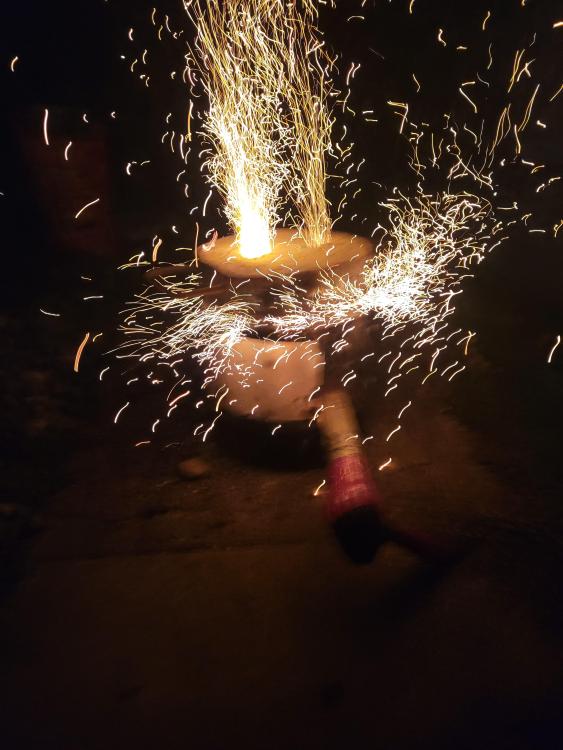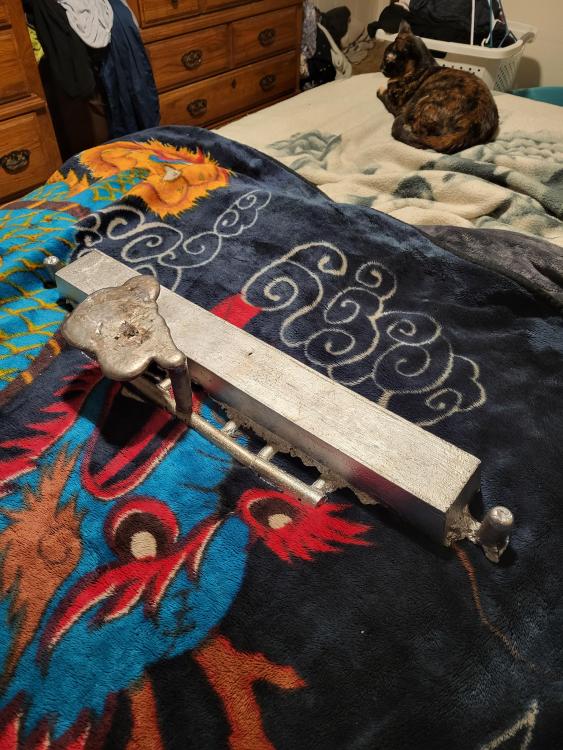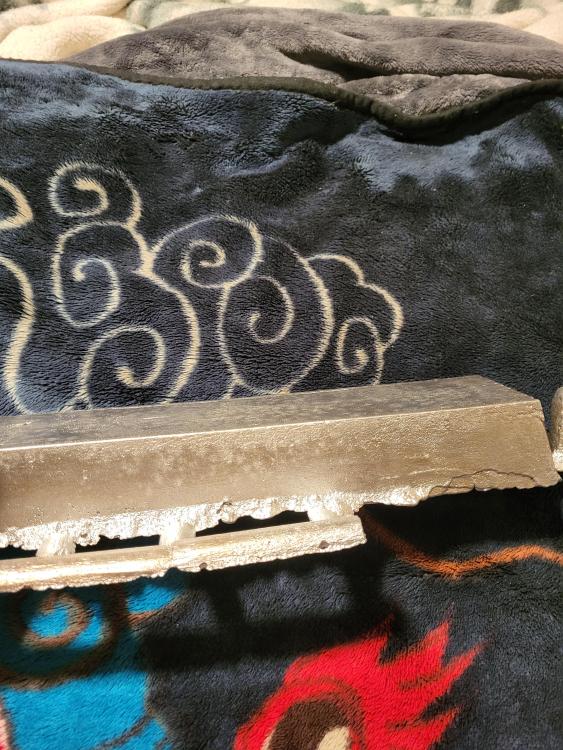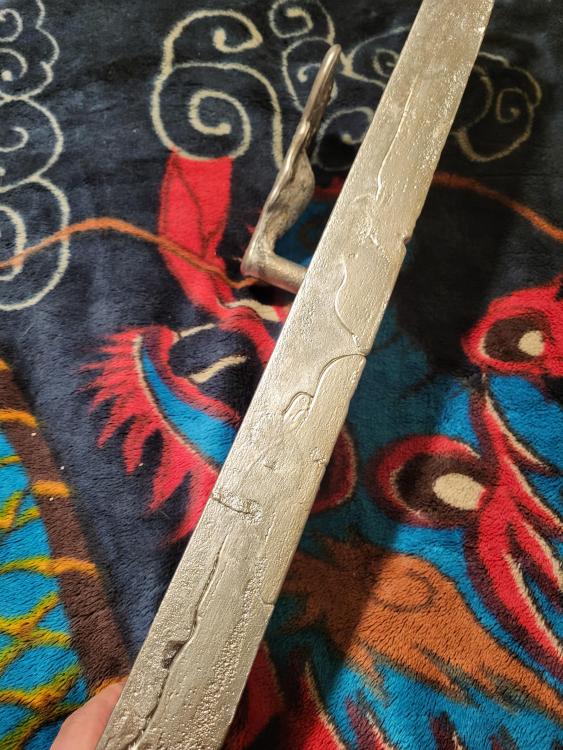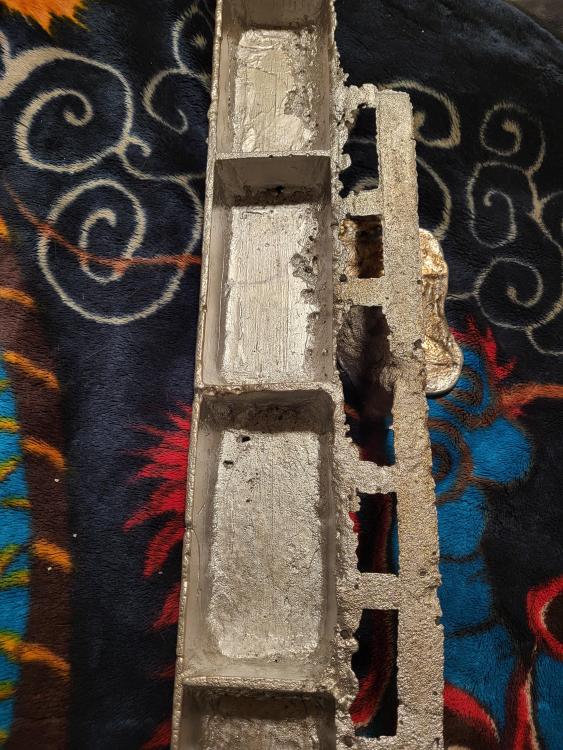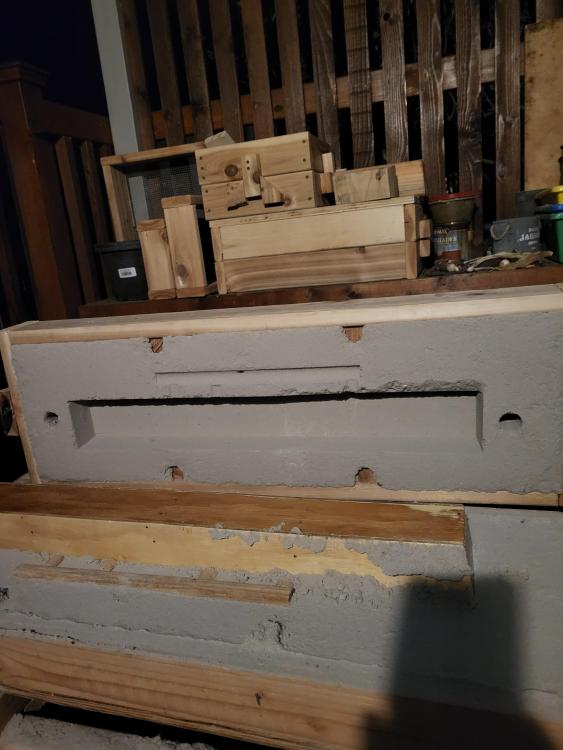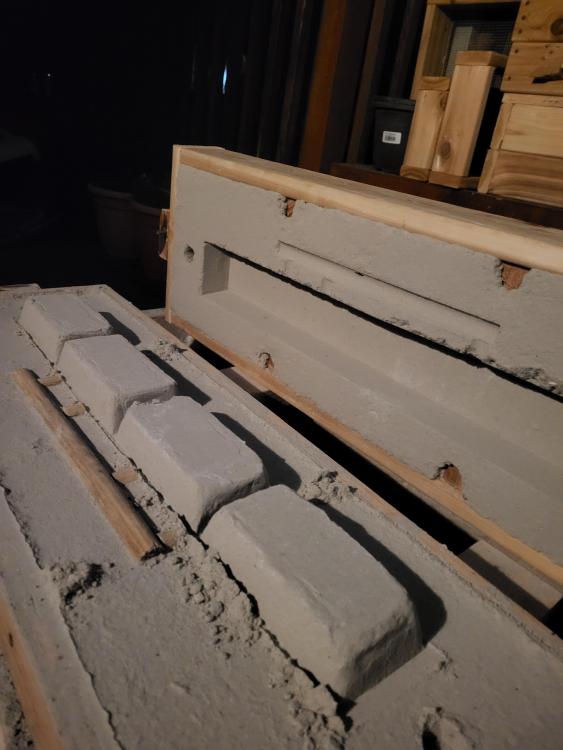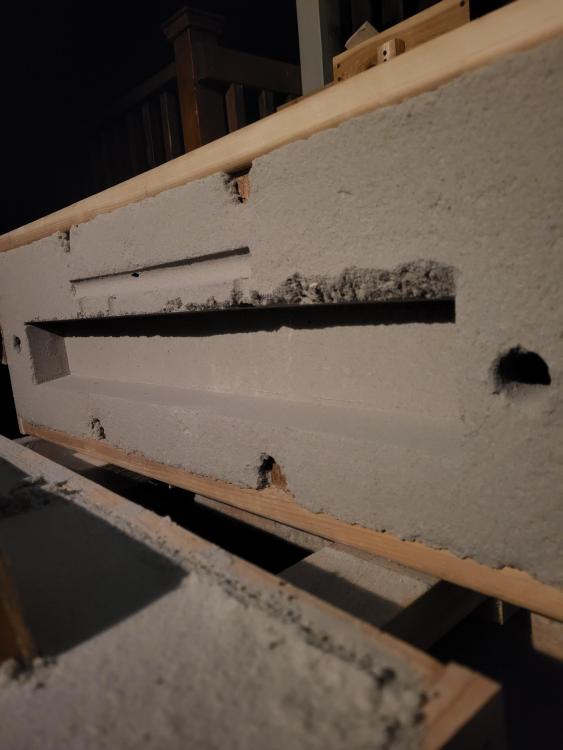-
Posts
1,580 -
Joined
-
Last visited
Content Type
Profiles
Forums
Articles
Gallery
Downloads
Events
Everything posted by Nobody Special
-
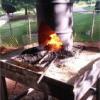
What did you do in the shop today?
Nobody Special replied to Mark Ling's topic in Blacksmithing, General Discussion
-
Well, yes and no. Apparently, some of the copper ore they would pull out of the ground in Germanic deposits wouldn't reduce to metal no matter what they threw at it. Turns out it was mostly nickel and arsenic with a little copper for good measure. Supposedly some of them thought the ore to be cursed somehow by whatever you call the German version of tommyknockers. So both the ore, and the potential goblin were nickels and when they finally isolated the metal... The needle bit was cool too. Oddly enough, they're not made singleton, but two at a time. The rod is cut, ground on both ends, then stamped in the middle, punched, broken apart, cleaned up, tumbled, sometimes finished in other metals or anodized or dipped in gold to make the eye stand out. Pins are similar, but apply molten glass. Like I said, took me a long-time taking side trips to watch videos on the open-hearth process, lead creep, needle making, the use of platinum leads in older style light bulbs to avoid breakage through different coefficients of expansion...you get the idea.
-
I recently picked up a copy of Metals in the Service of Man (Alexander and Street, 1958). There are more recent versions, but I didn't have $111 to spend on it, so I read the 1958 version. It's dated and the plot is a bit slow, but it's a surprisingly good read for a version of a book that's almost seventy years old. I wouldn't recommend it as the final word on metallurgy - for example it hadn't quite figured out titanium and talked about the open hearth process of producing steel as one of the contemporary leading methods. But for all that, it had a nice beat and you could dance to it. The general descriptions of metallurgy worked, if they weren't quite complete, and there were lots of interesting tidbits on the physical properties of iron and alloys, plus occasional bits of trivia such as the influence of metal production on the German goals in WWII, or explaining how the metal nickel took its name from the word for devil (incidentally, pumpernickel literally means farting demon, because rye bread tends to lead to flatulence). I would love to read the 1998 version if the price ever comes down or I can get an inter-library loan, and it would well be worth a read to someone looking to learn about metallurgy in general, including iron and its alloys. P.S. You may find yourself on some interesting internet side-trips, such as one I took to look up the production of steel needles, which was a lot cooler than it sounds and matched the book's description almost perfectly. Alexander, W. & Street, A. (1958). Metals in the Service of Man. Pelican.
-

Casting a Gingery Lathe
Nobody Special replied to Nobody Special's topic in Smelting, Melting, Foundry, and Casting
The aluminum gods did not smile, although they nearly cracked a sardonic grin. It looked gorgeous when I opened it up...and then not so much. The first attempt got minor washes and runs in the front...almost good enough, but a little bit of misfeeding. The top has one small inclusion and a shallow concavity about the size of a silver dollar from shrinkage in one spot. The back is a mess of hot tears though from it shrinking, but only on the one side. The interior also had rough sections on one end, probably trapped gas. On the plus side, I got a LOT of practice making molds and patterns and learned a good bit about handling it. I know how much metal it needs (just over a quart and a half), and I think I know what I screwed up...metal not hot enough and the risers needed to either sit behind or on top of the pattern. I was surprised that despite the cracks in the back the shrinkage was much less than I expected. The final piece was maybe a third of an inch shorter than the pattern, if that. If I try again and it fails, I may also make cores with a molasses binder and bake them hard. It would make things easier and I wouldn't have to roll the mold. -

Casting a Gingery Lathe
Nobody Special replied to Nobody Special's topic in Smelting, Melting, Foundry, and Casting
Finished the new pattern for the bed, rammed it up...and a quarter of it fell in. Did it again...same result, on the other side. Moved the risers, rammed it up...and it fell in again. (turns out the ribs that Gingery suggested for the cope (top part) make a weak point because they don't go all the way down). Then I got smart. Gingery originally has you put the cope on a board, right side up with the pattern in it, ram up the mold over the outside, then flip it over, put the drag (bottom part) on, and ram the sand in it AND the cores for the inside of the pattern, still in the cope. Then you roll it over one last time, take the cope off, and pull the pattern off of the cores before putting it back together. It's brilliant, but it kept falling in, no doubt from me varying from his sizes and putting risers on it. Then I got smart...I figured the whole reason for flipping it over so much was to create the cores...but when the top fell in, the cores were still inside the mold and perfectly good. So instead of starting from scratch, I rammed the top, which put less stress than ramming it over and flipping it twice...and part of the mold stuck to the pattern. (see attached pics). Dang it. Today, I cut the side of the ribs short, and only had the top fall in once before getting it right. I think if I'd added some kind of support at the bottom under the ribs, it would have survived flipping, but I got it when I left the bottom alone and re-rammed the top like last night. Poured 1.5 hours ago...waiting to break it open and see if the aluminum gods have smiled on us. -

bloom from scale.
Nobody Special replied to bluerooster's topic in Smelting, Melting, Foundry, and Casting
My one contribution is that unless you're forging all day most days, it's gonna take you a long minute to get enough scale. The last bloom I did took a lot of ore, I can't imagine collecting enough scale flakes to make anything more than a mini-bloom. You're in northern Georgia, right? If you want to make a bloom, there's a crap load of good goethite at and around Red Top Mountain, in huge fist size chunks that you can easily pull out of the red clay banks. I used to ruck it out in my ALICE pack. It was mined heavily there up through the Civil War. They still mine red ochre up there. Heck I've got some of it here in WA, not to mention a bit of mostly cooked bloom (unexpected GA thunderstorm and stupidly hot clay furnaces don't mix). If you're not near there, there's iron ore practically everywhere in North Georgia. I used to see limonite all over near Macon. -
So, yeah, you can leave one on the main line, but you have to tie it down (i.e. put on a number of hand brakes and test it with nothing but before locking it up and leaving). The Canada rail industry and that line in particular were going through insane cost cutting measures and the rail and engine were in crap shape, plus they'd gone down to one-man crews, something which was supposed to be illegal but they got done under "emergency" provisions. They changed a lot of this being allowed after the fact. I've heard that the engineer was somebody shifted over from management as a replacement for short manpower, but I don't know if it's true. What is true is that he supposedly called in the problem with the engine and a manager (s?) claimed to have signed off on it but didn't or didn't know what he was doing. He also only left the engine brakes on and two cars worth then flubbed the brake check badly, maybe on purpose. Problem with leaving one on the main line is that if anything happens, there's no derail. They had a siding with a derail and chose not to put it there, possibly because of time. There's more, but it just gets worse the more you know. Graniteville is about as bad but killed less people. An NS crew left the main line switched into an industry, derails off when they went on the law (couldn't legally work longer) and left but reported it as good in dark (unsignaled) territory. A train went into the industry at 40 mph with loaded chlorine gas cars right behind the engine and hit three or four more in the industry track. Busted three of them open (about 60,000 gallons of gas) and killed 11 people, put about 10 or 11 hundred in the hospital, about 120 or so with what became chronic issues. Two of the dead were the engineer and conductor - the conductor made it to the highway and coughed his lungs up on the dash of the car that picked him up. When you find out what goes through your major cities and towns on iffy trains and tracks, much less where you live on a daily basis, it gets scary in a hurry. Imagine a Graniteville had happened in Chicago, or downtown Atlanta. The only reason it didn't kill half the factory workers in Graniteville was because it was a weekend.
-
Because putting it in the dirt usually saves damage to equipment and people. Imagine for example, some yahoo gets a switch wrong from the mainline into an industry (say Norfolk Southern in Graniteville). Still tear things up fiercely, but at least a 12,000 ton train doesn't hit a building full of workers at 40 mph. Most incidents though involve derailing an engine or a few cars, as George said, often at low speeds. It's annoying and expensive, but if the car doesn't come off the truck, or the truck off the axles, then a lot of the time you can just kinda pull it over a re-railing device or wooden blocks back onto the track. Let them roll out a long ways and a cut of cars can pick up speed and do real damage, like that cut of 40 or so cars from a bomb train that rolled out up in Le Magentic and burned down half a town. Some of them prevent cars from rolling out of industries, running through a switch the wrong way, and onto the main line.
-
Some of the most fervent beekeepers I know are violently allergic, crazy nutters. I have found that a lot of people that think they're allergic aren't though. Many call anything yellowish and flying as bees, such as sweat bees and yellowjackets. Wasp venom works on a very different mechanism, so being allergic to one often doesn't mean you are allergic to the other. I've tanged one or two swarms every year for the last five years. I'm sure that it doesn't hurt that when bees swarm, they do it twice, and the first time they don't generally go far before settling. Something good to know - a low pitched sound and slow beats tend to settle them low, high pitched and you'll need a fricking stepladder. My first time I used a table spoon and a saucepan and put them in the top of my neighbor's plum tree that hasn't been pruned in 15 or 20 years and it took three tries and some cutting to get the queen down. The last several I used a big stockpot and a wooden spoon and got them down to three feet or lower. Tonk tonk, not tink tink. And like I said, totally agree that it shouldn't work. It's been tested extensively and far better entomologists than me say it has to be malarkey. E pur si muove. It doesn't tick me off like dowsing though. I know in my heart of hearts dowsing can't work, so it drives me nuts every time that I've done it and it has. My dad not only could find water but electric lines and utilities.
-
Be careful mentioning the Tuatha da Dannan too much, it can draw their attention and bring bad luck. Bad as walking widdershins around a church. I collect a lot of stories, but the best unfamiliar tall tales and stories I know aren't repeatable on a family site. But here's a couple of long sayings for ya in response to "How's it going?" "Fine as frog fur split four ways and tapered on the ends, but I'll be over it by dinnertime." "It's a dog eat dog world and I've got on milkbone boxers". and my personal favorite, "As busy as a three-legged cat covering up scat on a frozen pond". If you're in a hurry, "fair to middlin'" which is a grade of cotton, not a type of weather. Actually, I don't know if you know about telling the bees or tanging them. When you keep bees, you're supposed to tell them about anything important that happens in the house. If you don't share, they either don't stay or don't produce. When the beekeeper or someone in his house dies, someone is appointed to go inform the bees. I've done it. Tanging is the practice of beating pots, pans, or other metal objects to get a swarm to settle. It drives me crazy for the same reason that dowsing does; it's a bunch of superstitious nonsense that shouldn't possibly work, except it does somehow. My grandfather could tang bees right into a box or a trash can. I usually am happy if I can get them to settle somewhere where I don't need a ladder.
-
Anything all blue on the rails is maintenance and not allowed to be removed by anyone but maintenance. "If it's blue, it ain't you". They also use blue lights when occupying a track. You see it on flags, lights, and derails, many of which are portable.
-

What did you do in the shop today?
Nobody Special replied to Mark Ling's topic in Blacksmithing, General Discussion
I didn't pay close enough attention to the eclipse online to see a color change, but normally the coronas exhibit white light only. But...that said, you may have seen colors from the chromosphere, which tend to look sort of pinkish during an eclipse. -

What did you do in the shop today?
Nobody Special replied to Mark Ling's topic in Blacksmithing, General Discussion
Yes, although being in the rain shadow here is like ordering an extra dry water. We only had about 20 percent obscurement anyways and with the clouds out, it just got a little bit dimmer. Most of the year I prefer the weather to be bad. It keeps the tourists and the rich yahoos with second homes away. -
Well, not to go full-UPL, but unless you're contributing to sanctioned Native Alaskan subsistence bowhead whaling, which seems unlikely in Ohio, you might consider trying under the special case considerations from 26 U.S.C Section 170, subsection f, i.e. materials for research purposes, foods, or if you're really feeling your Wheaties, the taxidermy exemption. Depends on how you frame it and what support documentation you can provide. Honestly, I'm surprised they still call it the Alaska Eskimo Whaling Commission; the name is offensive as hell.
-
We used to have them die under the house once in awhile down in Texas, armadillos too. One I can tell you from keeping bees is that you don't want to go seal them in or bug bomb them in the walls or attic. If you seal them in, they tend to chew their way out in interesting places, like inside your living room. If you kill them, the honey ferments, sometimes grows mold, and draws bugs that then lay larva in the comb. Think a large stinky wet space in your ceiling that eventually pops open with fermented goop and bug larva dripping everywhere. Call the nice beekeeper in to take down your walls and then get someone to fix it after.
-

What did you do in the shop today?
Nobody Special replied to Mark Ling's topic in Blacksmithing, General Discussion
It was like every other early April day up here. Today's weather? 120 degrees with rains of frogs? Grey and cloudy, probably rain. The sun is as sackcloth and the moon is as blood? Little light rain - grey and cloudy. MMA fight between the Ice Giants and Aesir while the Fenrir wolf eats the moon and UFOs film it for intergalactic distribution? Never know it from here...grey and cloudy, probably rain. -
Silicon carbide (carborundum) contains well, silica and carbon, and is usually sintered together from powder or pressed to shape, so, I wouldn't be overly surprised if it had black powder on it. The carbide itself will usually be black or kinda dark brownish when rubbed depending on the composition when they made it. Silicon carbide is also about half again as heavy as graphite, but if you don't have a graphite crucible to compare it to, that doesn't help much. Of course, the real problem you have is that many silicon carbide crucibles contain graphite, just as many graphite clay crucibles contain silicon carbide. I dunno, if you use it and it starts coming apart too early, I would lean towards a possible counterfeit...or user error. Or rough handling during shipping. Or the stars are misaligned....
-
I thought the PTSD went away when I started sleeping again about eight months after I got back and I didn't get angry in such a hurry anymore. Whoops. Took a few years of hard drinking to figure out it was still hanging around, p.s. not a great cure. Not saying it wasn't fun trying but would not mash like or subscribe. Army then the Guard, 99 to present, nine in the big Army and 15-ish of it full time. Several of the 35 series (shhh), Leonard Wood, DLI, Goodfellow, Ft. Huachuca a couple of times, S. Korea, Hood (yuck), Eustis for 1-day (they later wrongly reported me AWOL), Little Creek (do NOT eat at the squids' nasty, filthy chow hall!!!), Jackson, Camp Williams twice, JBLM w a side-trip to al-Anbar from 07 to 08 (bloody surge), Ft. Gillem, Clay NGC, and JBLM again the last few years. E-7 and avoiding E-8 like the plague. Perfer et obdura.
-

Casting a Gingery Lathe
Nobody Special replied to Nobody Special's topic in Smelting, Melting, Foundry, and Casting
Good evening, It's got draft, more so on the long sides than the short...think the short sides could have used a hair more. For the falling in, I'm pretty sure I badly screwed up by getting the runner, and especially the risers too close to the pattern. I totally agree about removing the pattern from the mold, but I'm not sure how to go about it cleanly with the way Gingery has the cores sitting on the drag, and considering they're rammed concurrently, almost as an extension of it. Built that way, the tolerances are kinda tight for baking the cores and inserting them. The x-braces are clearly too small and don't have enough draft, which I'm not sure how to solve easily. Possible solutions, a. leave them out altogether and just use thicker braces going straight across, sanded to give them a slight draft, b. use two, wider X-braces to make the cavities and thus the cores larger (and thus come out easier), or c. put no braces at all on the pattern so it makes one giant core, then attempt to cut "X"s into it without collapsing the core. A. is probably the simplest. Or I could just go ahead and do one the tried-and-true Gingery method, but heck, I can't even make mac and cheese anymore without playing with the recipe. To speak to Leos's question, two reasons. Part of it is the challenge of doing things the bloody hard way and developing a skill, in this case casting. The reading I've been doing has been giving me a much better understanding of metallurgy and it is a fun, if sometimes exasperating challenge, not dissimilar to other craftwork like blacksmithing. I could crank out a functional wood lathe at various levels between a few minutes and a few hours, and I could work half a day and pick up a far better metal lathe than I can manufacture, used. The difficulty level goes down when I listen to good advice, which I don't always, but a dramatic failure is fun too, if not always at the time. The other reason is that the reason I'm casting a lathe to begin with is that my wife asked me to teach her to cast metal, which is hard to do from fabricating (she already welds better than me, if her old neck injury lets her). If she can pick up half of what goes into this, it will be a very nice foundation for whatever else she wants to play with. -

Casting a Gingery Lathe
Nobody Special replied to Nobody Special's topic in Smelting, Melting, Foundry, and Casting
Failure is always an option in experimentation, I just wish it wasn't so frequently the main option. Just tried to make the mold for the bed for the third time and failed the third time. Gingery had a pretty simple, but lousy system for feeding metal into the mold; he put a big honking sprue right on top of the pattern. That way tends to cause turbulence, poor feeding, and shrinkage that creates a lot of extra finish work. In my infinite wisdom, I thought I'd save myself a lot of finish work and put a regular feed system in with a sprue, runner, two risers, and four gates. Looked fantastic, but because the flask was so narrow to keep the weight down, I put it too close to the pattern and it was making a weak spot in the mold, with the end result that part fell in by one of the risers...three times, dang it. Got it figured now, longer gates so everything is further from the pattern. The other problem I'm a little more stuck on. Gingery has two or three braces going straight across the bottom. The pattern is put in the cope, which is filled, right side up, the whole thing is flipped over, the drag placed on it upside down, and the cores in the bottom of the pattern get made when the drag gets rammed. The last part of his process is flipping the whole thing over, lifting the cope off of the pattern which is left setting on the drag, then pulling the pattern off of the cores, which are left setting on top of the drag. That's bloody brilliant, but I found out in a hurry that when you try it with X shaped braces, to cut down on the Gingery's tendency to have the bed want to twist, the cores get stuck in the bottom. Not a little stuck, like I have to dig the smaller ones out with a pocketknife. I'm thinking I may have to rebuild the pattern from scratch and use either do it Gingery's way with thicker braces, or with much longer "X"s to create bigger spaces. Open to suggestions though. -

So I want to melt/smelt some brass...
Nobody Special replied to Apocalypse's topic in Smelting, Melting, Foundry, and Casting
What's viable now isn't what might be viable if the world markets or the technology shifts even a little. Think the last US tin production shut down in 1993, but there's tons of it in Alaska, and I think there's a fairly big casserite deposit in eastern Washington and Idaho for one. But heck, used to be low grade ores weren't bothering with, but the last few decades, the Bingham Canyon Mine in Utah shipped slurry in a two-percent copper ore something like thirty miles through pipes to a refinery at the north end of Salt Lake profitably. Really cool set up too and you can go see them float the copper on surfactant bubbles and electrolytically deposit it into big flat ingots. Huge smokestacks that seem to give off a tiny puff of steam about once an hour. Pewter does seem to vary, but it also seems to depend on where it's made. That would be a problem buying it off the scrap heap, but I get a lot of mine in thrift stores, where you can try to track down the maker from the markings and go from there. Most Brittania metal is fairly consistent, as is a lot of European pewter, which is almost the same stuff. Amercian pewter is hit and miss, and Mexican pewter mostly isn't. It's aluminum-ish. A lot of the East Asian stuff is almost pure tin. -

So I want to melt/smelt some brass...
Nobody Special replied to Apocalypse's topic in Smelting, Melting, Foundry, and Casting
I second the motion on fume fever sucking. Brass isn't usually forgeable, except for the stuff that is. Also, also, when you add the metals, you have to allow for loss to evaporation. With brass, and adding zinc just before pouring, it's usually about a five percent loss, or so sayeth Metals in the Service of Man. I forget how much tin ya lose with bronze, but you can't add it to copper shortly before casting the same way as adding zinc to make brass; it'll be too cold and may oxidize to boot. Not all alloys are easily reached in one melt either; with some metals sometimes you have to make intermediate hardening alloys before the final melt. The more I learn about casting, the more I can't believe that I first did it because I thought it would be easier and safer than forging.

